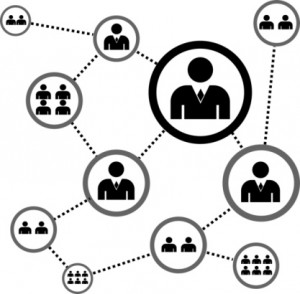The Power of Networks (Part 2)
By Asher Crispe: January 29, 2013: Category Inspirations, Networks of Meaning
 In complex systems theory there is great deal of discussion about phase transitions or what are more popularly known as ‘tipping points’ thanks to Malcolm Gladwell. Just think of the countless water molecules in a chaotic liquid state at room temperature and then imagine how they would look as you cool them off degree by degree. For some time there would be no apparent change that the naked eye can discern. If we were chart the progress from say 70º to 33º Fahrenheit we might expect (without prior experience to the contrary assuming this was the first time you had observed water) that the water would remain liquid indefinitely, only it would be colder. Nothing in our past experience (transitioning from 70º-33º F) prepares us for what ‘magically’ occurs when we hit 32º F. Suddenly all those myriad of free flowing molecules flip over and transform into a relatively stable ‘ordered’ crystalize structure known as ice. What happened? In the scientific parlance, the system underwent phase transition. 32º F was the tipping point.
In complex systems theory there is great deal of discussion about phase transitions or what are more popularly known as ‘tipping points’ thanks to Malcolm Gladwell. Just think of the countless water molecules in a chaotic liquid state at room temperature and then imagine how they would look as you cool them off degree by degree. For some time there would be no apparent change that the naked eye can discern. If we were chart the progress from say 70º to 33º Fahrenheit we might expect (without prior experience to the contrary assuming this was the first time you had observed water) that the water would remain liquid indefinitely, only it would be colder. Nothing in our past experience (transitioning from 70º-33º F) prepares us for what ‘magically’ occurs when we hit 32º F. Suddenly all those myriad of free flowing molecules flip over and transform into a relatively stable ‘ordered’ crystalize structure known as ice. What happened? In the scientific parlance, the system underwent phase transition. 32º F was the tipping point.
All of this comes to aid in our understanding of the kabbalistic notion of a ‘ketz’ or ‘end’ point within a phase of history. The heartbeat of history is punctuated in terms of times of exile and redemption. Each historical downturn (exilic time) gets interrupted once a critical mass of spiritual energy has been assembled. This then snowballs into a force that ushers in a new historical upturn (redemptive time) which rapidly flips the world on its head. If exile is likened to psycho-spiritual and social chaos, then redemption would be the introduction of a new order or rectified reality.
The example with water turning into ice above beautifully illustrates how we can get order out of chaos. It also informs us that the anticipation of a redemptive state is challenging because prior experience (cooling from room temperature to 33º) does not help us adequately gauge our future experience. All superficial signs point to more and more of the same and yet something radically different is coming. Practically, this may mean that from an everyday window of the world (perhaps it’s a TV), things look colder and colder outside. We lament the good old days when life was better and bemoan the social decay and general wasting away of human decency. In short, we feel certain that everything is getting worse all the while unsuspecting that in fact the exact opposite is true.
Incrementally we are making progress towards a better world. Peel back the tabloid headlines and the sensationalized news stories that magnify every speck of dirt for our viewing ‘pleasure’ and the real science-based analytics reveal a world which is measurably closer to our dreamed of and promised utopia than ever before. Not to suggest that we’ve made it there yet but that it’s closer than anyone would ever guess (just check out Steven Pinker’s well documented work The Better Angels of Our Nature for evidence of this).
The more connected we all become, the more we progress, the more rapidly we can close the remaining gap. The residual ‘chaos’ in our lives (called olam ha’tohu or the ‘world of chaos’ in Kabbalah) can ‘spontaneously’ erupt and in doing so let all the pieces go flying. With this, there is an open opportunity for those pieces to resettle and rearrange themselves. Wounds can be repaired. Mistakes can be corrected. Things can be made right. Something completely novel can be realized which bears no resemblance to what came before (this would be comparable to olam ha’tikun or the ‘world of rectification’ in Kabbalah). Ask yourself: What will the world look like when every one its 7 billion plus inhabitants are on Facebook? This is to say–how will humanity transcend its perviously isolationist social behaviors? What will emerge from our new global village? How might we chart a new course for ‘spaceship earth’ as Buckminster Fuller would call it?
What occurs when the Tzadik property (the relatable and righteous person) within all of us rules (Tzadik, the letter once again equals melech or ‘king’ [90]) and reaches its end (ketz) or tipping point? When the Tzadik as the ‘one who connects’ the ‘universal interface’ arrives at an ultimate state, this would be called a Tzadik sofit or a final Tzadik (remember this letter has a double form: the regular form that is placed at the beginning or within a word which has the numerical value of 90 and the final form which comes at the end of a word and has the alternative value of 900). When the capacity to connect (Tzadik) enters into the end stage (this would also be like the final redemption as well we hope to soon demonstrate), it morphs into its final form which is a network (the Tzadik sofit = 900 = reshet ‘network’). The image of the Tzadik who reaches the end (ketz) and phase transitions into the final Tzadik is the concept of Moshiach (the Messiah). Jewish messianism configures the key ‘connector’ as a builder of networks and then the network itself completes the work of redemption. The aspect of ‘Moshiach’ in the world and in ourselves according to Kabbalah, teaches us how to construct and maintain these networks and how to harness their power to accelerate positive changes in the world.
Looking at two historical examples of this (one is a subset of the other) from within Jewish particularity (but with universal relevance), first and foremost, the Jewish diaspora functioned and continues to function as a network. With the homeland of Israel we are dealing with a centralized network (with all other Jewish communities being like branches of this tree trunk whose bulk belongs to a dedicated land) and without Israel, it would be like a decentralized network. In the future, in the messianic age, an interesting third possibility arises in that the Midrash speaks about the borders of Israel expanding to encompass the entire world. Abstractly, this signifies a time when the ‘center’ of the network is (in a certain sense) now everywhere. Everything becomes a distributed network in a globalized society. Another way of looking at it would be to see this future network design as accommodating the best of both worlds. It simultaneously orchestrates its web to have the dual advantages of centralized and decentralized networks. Territory coexists with deterritorialization. Utopia (read ou-topos or ‘not’ + ‘place’) would be a place that is the absence of a place. Where better than in the off-site (or non-site) of web-sites of the ephemeral digital universe?
 Secondly, the Lubavitcher Rebbe (Rabbi Menachem Mendel Schneerson) exemplified an extreme example of leadership that sought to connect with everyone he encountered. At the same time, he channeled that leadership (the image of a king or Tzadik model) into the creation of a global network of emissaries (shulchim) who would in turn grow the network of Chabad centers. Now on the one hand, this seems to have been a centralized network with the Lubavitch world headquarters in Crown Heights New York, but on the other hand, the network was set up so that each center would have its own self-sustainability. Hence, to a very large degree, the Chabad centers were established as a decentralized network. By making the jump to a distributed network with this modern day movement, it would be as through the Tzadik (on some level) turns into the final Tzadik which is just the network itself. A star becomes a galaxy.
Secondly, the Lubavitcher Rebbe (Rabbi Menachem Mendel Schneerson) exemplified an extreme example of leadership that sought to connect with everyone he encountered. At the same time, he channeled that leadership (the image of a king or Tzadik model) into the creation of a global network of emissaries (shulchim) who would in turn grow the network of Chabad centers. Now on the one hand, this seems to have been a centralized network with the Lubavitch world headquarters in Crown Heights New York, but on the other hand, the network was set up so that each center would have its own self-sustainability. Hence, to a very large degree, the Chabad centers were established as a decentralized network. By making the jump to a distributed network with this modern day movement, it would be as through the Tzadik (on some level) turns into the final Tzadik which is just the network itself. A star becomes a galaxy.
Additional insights into the redemptive nature of networks will continue in Part Three.
http://www.interinclusion.org/inspirations/the-power-of-networks-part-3/
http://www.interinclusion.org/inspirations/the-power-of-networks-part-1/
The Power of Networks (Part 2),














;)
;)
;)
;)
;)
;)
;)
;)
;)
;)
